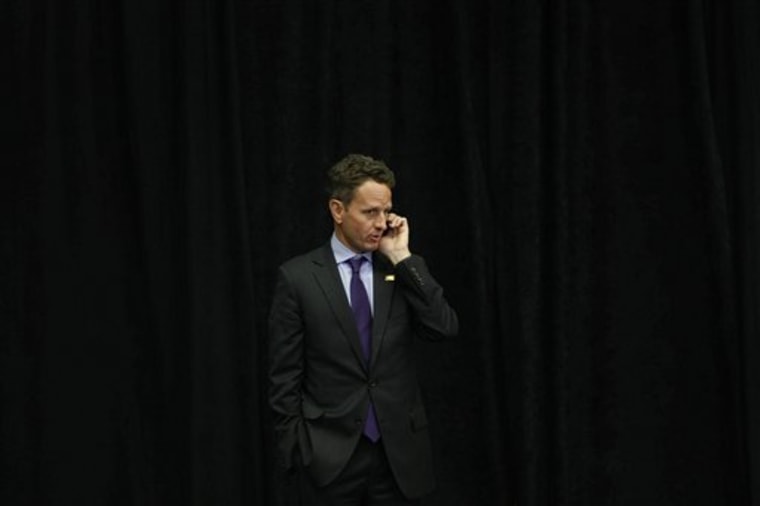As the federal government propped up the housing market and braced for the collapse of General Motors this spring, Treasury Secretary Timothy Geithner capped a busy week with phone conversations with three men.
The first was Lloyd Blankfein, the CEO at Goldman Sachs Group Inc.
The second was Jamie Dimon, the CEO at JPMorgan Chase & Co.
The third was President Barack Obama.
Dimon and Blankfein are members of an exclusive club: Along with executives at Citigroup Inc., they are among a cadre of Wall Street executives who have known Geithner for years, whose multibillion-dollar companies survived the economic crisis with his help, and who can pick up the phone and reach the nation’s most powerful economic official.
Geithner’s calendars, obtained by The Associated Press under the Freedom of Information Act, offer a behind-the-scenes glimpse at the extraordinary influence of three companies. More than any other company or any of their rival banks, Goldman, Citi and JPMorgan can get Geithner on the phone several times a day if necessary, giving them an unmatched opportunity to influence policy.
“They’re people he has relationships with and who he can trust,” said Taylor Griffin, a Treasury Department spokesman during the George W. Bush administration and an adviser to the 2008 presidential campaign of John McCain. Griffin defended Geithner’s relationships with industry executives. “There’s only so much time in the day and you can only talk to so many people. You choose the people whose point of view you value.”
There is nothing inherently wrong with senior Treasury Department officials talking to industry executives, or even with the secretary keeping tabs on the market’s biggest players. But the calendars offered fodder for critics who say Geithner is too close to the Wall Street firms he helped bail out following the economic meltdown.
“It’s appropriate for Treasury officials to keep in touch with those who work in the markets every day, particularly when the economy and the markets are so fragile,” Treasury spokesman Andrew Williams said.
Not all players in the market enjoy the same access. In the first seven months of Geithner’s tenure, his calendars reflect at least 80 contacts with Blankfein, Dimon, Citigroup Chairman Richard Parsons or Citigroup CEO Vikram Pandit.
Geithner had more contacts with Citigroup than with Rep. Barney Frank, D-Mass., who leads the effort to approve Geithner’s overhaul of the financial system. Geithner’s contacts with Blankfein alone outnumber his contacts with Sen. Chris Dodd, D-Conn., chairman of the Senate Banking Committee.
Partly this is explained by the extraordinary clout of these companies. Goldman, JPMorgan and Citigroup are among the dominant Wall Street players. Their executives can move not just markets but entire economies. Treasury invested heavily in all of them to keep the industry afloat, and Citi faces tighter scrutiny because Treasury owns a larger stake in the bank.
But size does not tell the whole story. Treasury has a huge financial stake in North Carolina-based Bank of America Corp., but CEO Ken Lewis appears on Geithner’s calendars only three times. Morgan Stanley CEO John Mack also appears three times.
Smaller banks have felt frozen out of the process as the Treasury Department, first under President George W. Bush and now under President Obama, pushed through massive financial plans, said Wayne Abernathy, a lobbyist with the American Bankers Association, which represents banks of all sizes.
“Their focus was the big banks,” he said. “They only focused on the guys that occupied the biggest space in front of them. We constantly remind them that there are hundreds of other banks, and they’ve had to adjust their programs to take other guys into account.”
Geithner’s relationship with Goldman, JPMorgan and Citigroup dates to his tenure as president of the Federal Reserve Bank of New York, where he helped put together multibillion-dollar taxpayer bailouts for Wall Street last fall. Critics said the government was unwilling to let banks suffer the consequences of their bad bets.
When he arrived in Treasury’s corner office, Geithner brought those relationships with him.
The prominence of those relationships is clear by the company they keep on Geithner’s calendars.
On March 24, just after Geithner announced plans to help banks sell off toxic debts left over from the housing market meltdown — which stood to be a boon for big banks — his calendars reflect a busy morning. He had a briefing on terrorism financing, a meeting on tightening financial regulations and a prep session for congressional testimony.
Geithner emerged to take just three phone calls, from Vice President Joe Biden, New York Attorney General Andrew Cuomo and, shortly before heading to Capitol Hill, from Dimon.
Officials at JPMorgan, Citigroup and Goldman had no comment on Geithner’s calendars. Geithner did not take questions during his only public appearance Thursday, a conference call with reporters. Asked about Geithner’s contacts with Wall Street, White House spokesman Robert Gibbs said the administration had “tremendous confidence in his stewardship and in his leadership.”
Geithner’s predecessor at Treasury, Henry Paulson, similarly kept in close touch with Wall Street power brokers. In particular, he was criticized for his close ties to Goldman, his former employer.
But Geithner’s calendars show Geithner is too close to Wall Street, said Simon Johnson, a former chief economist with the International Monetary Fund and professor at the Massachusetts Institute of Technology’s Sloan School of Management.
“Your worldview in the middle of a crisis depends on whom you talk to and what their perspective is, and you need a broad cross-section of opinions to truly understand what’s happening,” Johnson said.
By seeking information from such a narrow group of contacts, Johnson said, Geithner risks limiting his exposure to the views of his trusted banker colleagues.
Geithner must believe he can set aside their inherent biases, he said, adding, “I don’t see how you do that.”
